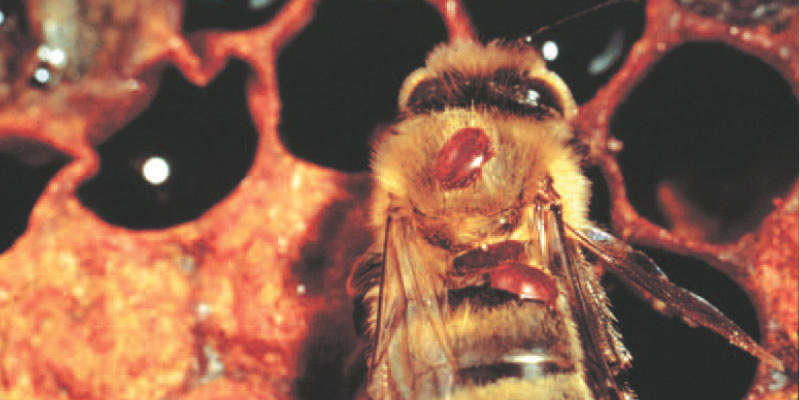Varroa mite
Introduction
The varroa mite, Varroa destructor, [Fig 1] is an external parasite of honey bees and, globally, the most serious threat to the Western honey bee, Apis mellifera, which has few natural defences against varroa.
A parasite that feeds on the bee and acts as a vector for viruses, varroa is widely believed to be at the core of unexplained bee losses (Colony Collapse Disorder) across the world. Untreated, colonies will die in just a few years but signs of infestation may not be obvious until infestation levels are high, by which stage the colony is at great risk.
Early detection, therefore, is essential and beekeepers should remain constantly vigilant.
Detection
Adult varroa mites are reddish-brown in colour, oval and small in size but visible to the naked eye (1.5 mm by 1 mm) with eight legs [Fig 2]. Varroa mites are usually seen as reddish spots on the white larvae. [Fig 3] or behind the head or nestled between the abdominal segments of the adult bee. [Fig 4]
Check for:
- Mites in hive floor debris (purpose-made varroa floors help)
- Mites visible on adult bees, on wax combs and in cells
- Varroa on uncapped and examined drone brood
- Diagnostic treatment with approved acaricides and methods
- Warning signs:
- Sudden crash in adult bee numbers
- Twisted/Shrivelled wings, small abdomens or other deformities
- Poor general colony health, irregular brood pattern
Prevention
Where possible, the following factors, which can accelerate the spread of the varroa mite, should be avoided:
- Migratory beekeeping
- Transfer of bees between colonies
- Allowing colonies (perhaps already weakened by varroa) to become vulnerable to robber bees
Treatment
It is very important to use a product that has been licensed for varroa control and has been thoroughly tested and approved for efficacy, safety and quality. Apistan and Apiguard are each registered in approximately 60 countries globally and are two of the world's leading varroa medicines.
Tips:
- Monitor infestation levels to assess mite count compared with harmful levels and to check effectiveness of current method of control
- Use a combination of methods (Integrated Pest Management), such as combining both biomechanical methods and chemical treatments
- Use approved varroacides such as Apistan and Apiguard with proven efficacy and safety
- Follow manufacturers guidelines; incorrect use may result in residues and promote the development of resistance
- Use a co-ordinated approach by developing a treatment programme with other local beekeepers to reduce the likelihood of re-infestation





